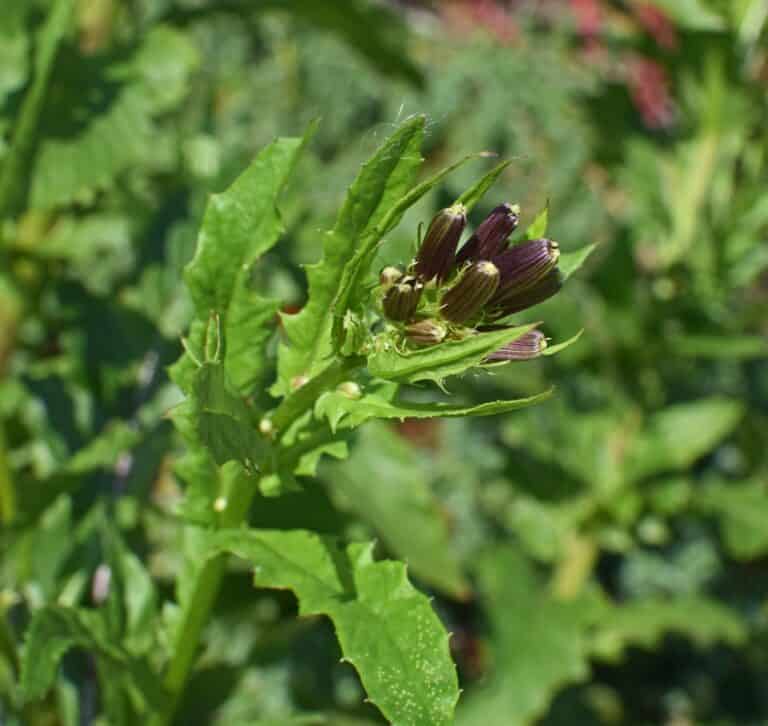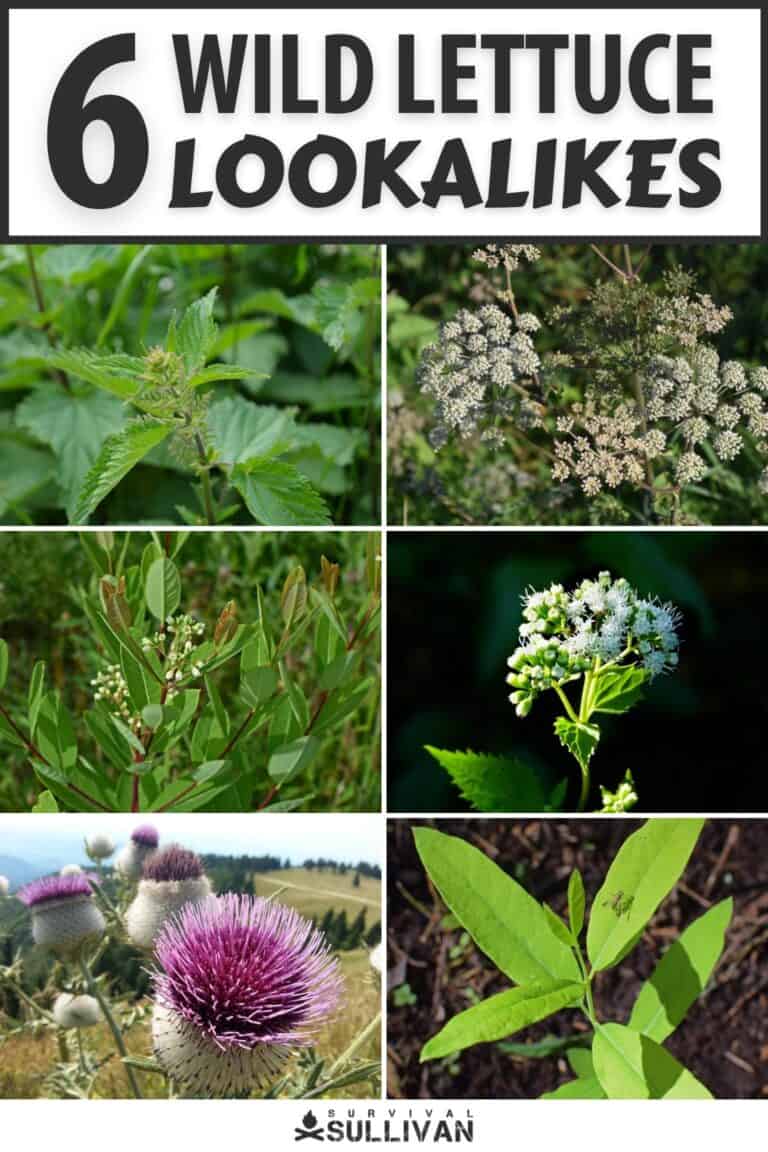When you go out into the wild voluntarily or wind up stuck out there, it can be comforting to know there are many resources that can help you.

But there is also a lot that can hurt you, and so it’s important to be aware of your surroundings.
Wild lettuce is one such plant with beneficial medicinal uses that might aid you, but without expert knowledge of it, you could end up picking one of several dangerous lookalikes instead.
The consequences of eating a toxic plant can range from “miserable” to “deadly,” and you don’t want to deal with either in a deep country.
We will try to keep you safe from that unfortunate outcome. In this article, we will explore six wild lettuce lookalikes and discuss the dangers they pose.
What is Wild Lettuce?
Wild lettuce is a plant that belongs to the daisy family. It is a common sight in North America and Europe, where it often grows in fields and along roadsides.
The plant gets its name from its leaves, which are large and lobed, and its flowers, which are white or yellow.
Wild lettuce is better known for its milky sap, which contains a number of active compounds.
These include lactones, which have sedative and analgesic effects, and sesquiterpene-lactones, which have anti-inflammatory properties.
Wild lettuce has a long history of use as an herbal remedy in various cultures, and it is still used today to treat a variety of conditions, including insomnia, chronic pain, and anxiety.
To say that this helpful plant might come in handy during a survival situation is an understatement.
However, there are quite a few dangerous plants that look very similar to wild lettuce at various stages of its lifecycle. Make a mistake, and you’ll be in for a bad time…
Poisonous Imposters are Everywhere
Before we get into the six plants that closely resemble wild lettuce, it’s important to note that these imposters can be found all over North America and elsewhere in the world.
So even if you think you know your plants, it’s always best to err on the side of caution and avoid consuming any plant unless you are 100% sure of its identity.
To complicate matters, certain features you might use to positively ID a plant may not present at certain stages of its growth, or might be absent entirely in polymorphic species.
A casual or haphazard assessment could see you doubled over in pain or, quite literally, belly up, paralyzed and struggling to breathe with failing lungs.
In your area, wild lettuce might stand pretty much alone, making it a safe and reliable choice. Or it might have one, two or several dangerous lookalikes.
It all depends, but the only way you’ll be able to count on your wilderness lore is by getting out there and putting in the time.
Relying on books, apps and speculation in a live event is a great way to make a bad situation worse.
Watch Out for These Dangerous Lookalikes
The following plants are some of the most common lookalikes for wild lettuce.
If you can’t positively ID a plant as wild lettuce, assume it is one of these and take appropriate precautions…
Poison Hemlock
Poison hemlock (Conium maculatum), also known as wild hemlock or just hemlock, is a flowering plant in the carrot family.
It is native to Europe and Africa but it has been introduced to North America and elsewhere in the world, subsequently flourishing, where it is considered a hazardous weed.
Poison Hemlock grows up to six feet tall, like wild lettuce, and has large, umbrella-like clusters of white flowers, again quite similar to wild lettuce.
All parts of the plant are poisonous, but the roots and seeds are the most dangerous.
Poison Hemlock contains several alkaloids, including coniine and gamma-coniceine, which can cause paralysis and even death in humans and animals if ingested.
The toxins can even be absorbed through skin contact. Lethargy and seizures are likely in smaller doses, with death usually occurring from paralysis of the diaphragm.
The plant is so deadly it has been used as a method of execution since ancient times, and it was infamously used to kill Socrates.
Today, poison hemlock remains a dangerous threat to the unwary, and anyone who comes into contact with this plant should seek medical attention immediately.
Dogbane
Dogbane (Apocynum cannabinum), also known as Hemp Dogbane or Indian Hemp, is a perennial herb in the family Apocynaceae.
The plant is native to North America, where it can be found growing in woods, pastures, and along roadsides. Dogbane is a slender, erect plant that typically reaches a height of over 7 feet if left alone.
The leaves are narrow and tapering with a pronounced point, and the flowers are small and white. The fruit is a two-lobed capsule that contains numerous seeds.
All parts of the plant are poisonous if ingested, and the reddish sap can cause pronounced skin blistering. Ingestion of the plant can cause vomiting, diarrhea, hallucinations and death.
Despite its toxic properties, Dogbane has been used medicinally, if carefully, by Native Americans for centuries.
The root was used to treat respiratory problems, and the leaves were boiled to make a tea that was believed to relieve pain.
Today, Dogbane is still sometimes used in herbal preparations for these same purposes.
This is another plant that is easy to mistake for wild lettuce, particularly when young, and though it has medicinal properties it is all too easy to misuse it, especially when it is mistaken for something else.
Stinging Nettles
Stinging nettles (Urtica dioica), also known as common nettle or burn nettle, are a common sight in gardens and woodlands across the world.
Herbaceous perennial plants that can grow up to 7 feet in height, the leaves are opposite, palm-like and deeply serrated usually dark green with a red or purple hue.
The flowers are small and pretty, usually a pale green-white, blooming from June to September.
Stinging nettles are found throughout Europe, Asia and North America, but don’t let their mild appearance deceive you: as the name suggests, these plants pack a nasty sting.
The stinging nettle gets its name from the thousands of tiny, translucent needles that cover its leaves and stems.
These needles are actually tiny hairs that have been hollowed out and filled with a poisonous substance that is a potent mixture of histamines and other irritating compounds.
When the plant is touched, the needles break off and release the acid into the skin, causing a fiery burning sensation and accompanying rash.
Most who blunder into nettles don’t soon forget it. It is sometimes mistaken for wild lettuce due to its height.
Despite its sting, the stinging nettle has many medicinal uses and is even popular culinarily.
The leaves can be cooked and eaten like spinach, and the roots can be roasted and ground into a coffee replacement.
Nettle tea is known to be very high in vitamins C and K, and it is often used as a natural remedy for hay fever and allergies.
This is a case where mistaking a plant for wild lettuce probably won’t have life-threatening consequences, but it will still definitely ruin your day.
Snakeroot
Snakeroot (Polygala senega), aka senegaroot or mountain flax, is an herb is native to North America and can be found in woods and fields from Canada to Georgia. It has small, oval-shaped leaves and clusters of white or pink flowers.
At first glance, it would be easy to mistake a snakeroot for a harmless wildflower. The plant derives its colloquial name from its resemblance to a snake’s tail.
Used medicinally by American Indians for centuries, snakeroot was an ingredient in many indigenous snakebite remedies.
The root was chewed and the juice swallowed or a tea made from the roots was used instead. It is still sometimes used in modern herbal preparations for colds, flu and bronchitis.
While it may have some benefits when used properly, snakeroot can be surprisingly harmful in high concentrations.
The toxins present in snakeroot are similar to those found in poison ivy and poison sumac, and can cause severe gastrointestinal distress, including violent vomiting and explosive diarrhea, when ingested. Nasty!
In large enough quantities, these toxins can lead to organ failure or intestinal lesions.
Although not as deadly as other lookalikes on this list, it is important to exercise caution when encountering this plant in the wild and especially if you are looking for wild lettuce instead!
Milk thistle
Milk thistle (Silybum marianum), also known as Saint Mary’s thistle or blessed milkthistle, is a tall, spiny plant with large, green leaves and colorful purple flowers.
It is native to Europe, Asia and North Africa, but has been introduced to other parts of the world, including North America, where it has naturalized.
The plant gets its common name from the milky white sap that exudes from its stems when it is cut. This sap contains silymarin, a compound that is thought to have liver-protecting properties.
While milk thistle is considered an invasive weed in some parts of the world, it is also grown as an herb for its medicinal properties.
The active ingredient in milk thistle is silymarin, which is thought to protect the body from toxins and help wounds to heal. The exact mechanisms by which silymarin works are not fully understood.
However, because it is on this list you probably guessed, rightly, that this weed can still hurt you.
And you’d be right! Milk thistles sometimes contain high amounts of mycotoxins, a type typically found in mushrooms and other fungi, which can cause serious gastrointestinal distress.
Milkweed
Milkweed (Asclepias syriaca) is a common wildflower that is found across North America. Milkweed plants grow to a height of 2-3 feet, and they have large, oval leaves and clusters of small, white flowers.
Milkweed is considered to be an invasive species in some parts of the world, but it plays an important role in the ecosystem as a food source for Monarch butterflies.
The plant gets its name from the milky sap that is produced by the leaves and stems. This sap contains a variety of toxins, including cardiac Glycosides and quinine.
These toxins make milkweed unpalatable to most herbivores, but the plant is a key food source for the Monarch butterfly.
The Monarch butterfly larva feeds exclusively on milkweed leaves, and as a result, the butterflies are poisonous to predators.
This sap also prevents mammals from using potassium and sodium effectively at the cellular level, causing all sorts of havoc in the body.
The sap is toxic enough that indigenous tribes used it to poison arrows and spearheads.
Even incidental contact may be enough to cause negative effects, and ingestion will cause severe health issues, including organ failure, coma and death. Easily mistaken for young wild lettuce, especially when not blooming.
Wild Lettuce Lookalikes Can be Deadly!
While wild lettuce may have some legitimate survival benefits, it is important to be aware of the dangers of lookalikes.
Some of these plants contain toxins that can cause serious health issues or death when ingested.
It is essential to exercise caution when identifying and harvesting wild lettuce and to make sure you are not mistaking another plant for it!


Tom Marlowe practically grew up with a gun in his hand, and has held all kinds of jobs in the gun industry: range safety, sales, instruction and consulting, Tom has the experience to help civilian shooters figure out what will work best for them.
